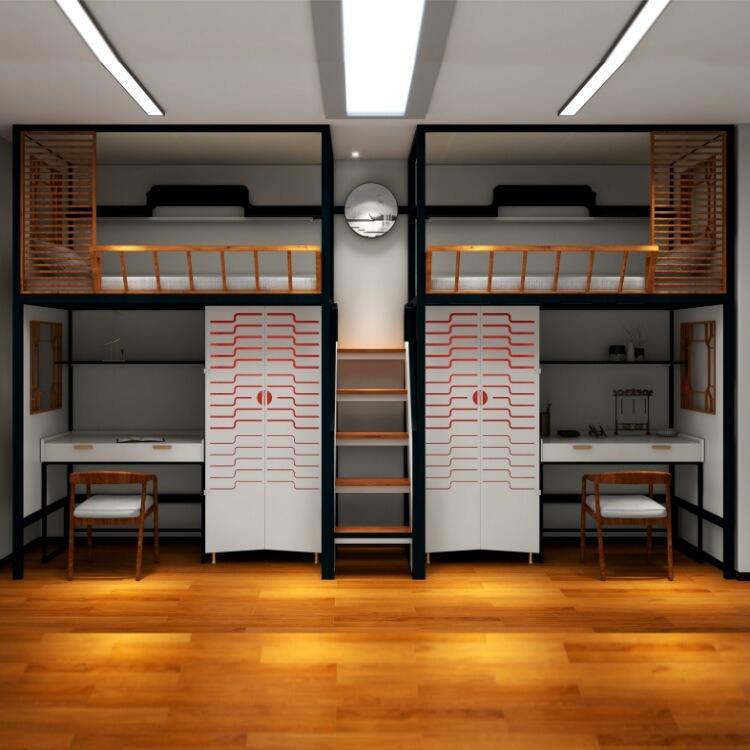완벽한 금속 침대 솔루션 선택을 위한 필수 가이드
생활 공간을 극대화하면서도 편안함과 내구성을 보장할 수 있는 제품으로 금속 이층침대는 주택 및 기숙사 모두에 있어 훌륭한 선택입니다. 이러한 다용도 가구들은 기관용 기본형에서 크게 발전하여 현대 생활 공간에 어울리는 스타일리시하고 실용적인 솔루션으로 자리 잡았습니다. 어린이 방, 대학 기숙사 또는 게스트룸을 가구로 꾸미는 경우에도 귀하의 특정 요구에 맞는 최고의 투자를 하기 위해서는 다양한 요소들을 신중하게 고려하는 것이 중요합니다.
오늘날 시장에서는 전통적인 싱글형 수직 이층침대부터 작업 공간과 수납 솔루션을 갖춘 보다 복잡한 구성에 이르기까지 인상적인 다양한 금속 재질의 이층침대 디자인이 제공됩니다. 이러한 침대 솔루션의 주요 특징을 이해하면 기능성, 안전성, 스타일을 고려하면서 공간을 최대한 활용할 수 있는 선택을 할 수 있습니다.
디자인 및 구성 옵션
클래식 이층침대 구성
가장 전통적인 금속 이층침대 구성은 수직으로 쌓인 두 개의 동일한 매트리스 공간이 있는 싱글형 이층침대입니다. 이 디자인은 바닥 면적을 최대한 활용해야 하는 어린이 방 또는 공동 공간에 이상적입니다. 천장이 높은 방의 경우, 세 명의 사용자를 수용할 수 있으면서도 상대적으로 작은 공간을 차지하는 트리플 이층침대를 고려할 수도 있습니다.
또 다른 인기 있는 변형은 더블 침대 위에 싱글 침대가 배치된 트윈오버풀(twin-over-full) 디자인으로, 하단 침대에 더 넓은 수면 공간을 제공합니다. 이 구성은 나이가 다른 자녀를 둔 가족이나 어른이 가끔 하단 침대를 사용해야 할 때 이상적입니다. 하단의 추가 공간은 유닛의 전체 크기를 크게 증가시키지 않으면서도 더 큰 편안함을 제공합니다.
특수 구성
현대식 금속 이층침대 디자인에는 기능성을 높이기 위한 추가 기능이 종종 포함됩니다. L자형 구성은 상단 침대 아래에 모서리 작업 공간을 만들어내어 학생이나 집 사무실에 적합합니다. 일부 모델에는 책상, 선반 유닛 또는 수납 서랍이 내장되어 있어 좁은 공간에서도 공간 절약형 솔루션으로 훌륭합니다.
퓨톤 이층침대는 하단 레벨에 변환형 소파를 갖추어 수면 공간과 좌석 공간을 결합합니다. 이 다용도성은 소파와 침대 등 가구가 하루 종일 다양한 기능을 수행해야 하는 스튜디오 아파트나 다목적 공간에서 특히 유용합니다.
재료 품질 및 구조
금속 종류 및 마감 처리
금속 이층침대의 내구성은 주로 제작에 사용된 금속의 종류에 크게 좌우됩니다. 강철은 가장 일반적으로 사용되는 소재로, 뛰어난 강도와 내구성을 제공합니다. 스크래치와 찍힄재에 강하며 녹이 생기는 것을 방지하는 파우더 코팅 마감 처리가 된 제품을 선택하세요. 일부 고급 모델에는 부식 저항성이 뛰어나면서도 전체 무게를 가볍게 유지하는 알루미늄 부품이 사용되기도 합니다.
금속 튜빙의 두께 역시 침대의 안정성과 내구성에 중요한 역할을 합니다. 게이지 숫자가 높을수록 금속이 얇음을 나타내므로 보다 우수한 강도와 내구성을 위해 12~16게이지 사이의 낮은 숫자를 선택하는 것이 좋습니다. 고품질의 용접 및 보강된 연결 지점은 정기적인 사용 중에도 구조가 안정적으로 유지되도록 보장합니다.
안전 기능
금속 이층침대를 선택할 때 안전이 최우선되어야 합니다. 상단 침대에 풀 레인지 가드레일과 견고한 사다리 고정장치가 있는 모델을 선택하세요. 가드레일은 매트리스 표면 위로 최소 5인치 이상 올라와 있어야 수면 중 실수로 떨어지는 사고를 방지할 수 있습니다. 부품 간 연결 부위는 매끄럽고 날카로운 모서기나 돌출된 하드웨어가 없어야 합니다.
사다리 설계가 견고한 밟는 부분과 편안한 손잡이를 제공하는지 확인하세요. 일부 모델에는 각도가 적용된 사다리나 내장형 계단이 있어 특히 어린 아이들이나 고령 사용자에게 기존의 수직형 사다리보다 더 안전하고 쉽게 이용할 수 있습니다.
공간 고려 및 방 배치
크기 요구 사항
금속 이층침대를 선택하기 전에 천장 높이를 포함하여 사용 가능한 공간을 정확히 측정하십시오. 일반적으로 이층침대는 상단 침대 사용자에게 충분한 머리 공간을 확보하기 위해 최소 8피트(약 2.44미터)의 천장 높이가 필요합니다. 침대 정리 및 시트 교체를 위한 추가 공간도 확보해야 합니다.
침대의 배치가 방 안의 다른 가구 및 동선에 미치는 영향을 고려하십시오. 안전한 접근과 편안한 이동을 위해 침대 주위에 최소 2피트(약 0.61미터)의 여유 공간을 확보하십시오. 방에 경사진 천장이나 창문, 환풍구 같은 건축 구조물이 있다면 배치 계획에 이를 반영하십시오.
방 배치 최적화
금속 이층침대를 전략적으로 배치하면 방의 전반적인 기능성을 향상시킬 수 있습니다. 안정성을 위해 침대를 단단한 벽 쪽으로 배치하고 자연광이 두 침대에 어떻게 영향을 미칠지 고려하십시오. 다목적으로 사용되는 공간이라면 자는 공간, 공부 공간, 수납 공간을 분명히 구분하는 배치를 계획하십시오.
2단 침대에 어울리는 수납 솔루션을 도입하여 수직 공간을 효과적으로 활용하십시오. 벽면에 선반, 걸이용 정리 도구, 침대 아래 수납 박스 등을 활용하면 정돈된 환경을 유지하면서 2단 침대 배치의 공간 절약 효과를 극대화할 수 있습니다.
조립 및 유지보수 고려사항
설치 요구 사항
일반적으로 금속제 2단 침대는 조립이 비교적 간단하지만 안전하고 오래 사용하기 위해서는 올바른 설치가 매우 중요합니다. 구매한 제품에 필요한 모든 도구와 부품이 포함되어 있는지 확인하고 제조사의 조립 지침을 주의 깊게 따르십시오. 대부분의 금속제 2단 침대 디자인은 볼트로 조립하는 모듈식 부품으로 구성되어 있어 초기 조립뿐 아니라 향후 분해도 보다 용이하게 할 수 있습니다.
특히 무겁거나 복잡한 구성의 경우에는 전문가의 조립 지원이 필요한지 고려하십시오. 일부 소매점에서는 설치 서비스를 제공하는데, 올바른 설치와 구조적 안정성을 보장하기 위해 추가 비용을 지불하는 것이 가치 있을 수 있습니다.
장기 관리
정기적인 유지보수를 통해 금속 이층침대의 외관과 구조적 안정성을 오래 유지할 수 있습니다. 사용 과정에서 체결 부품이 느슨해질 수 있으므로 주기적으로 모든 볼트와 연결 부위를 점검하고 조여 주세요. 먼지가 쌓이는 것을 방지하고 마감 상태를 유지하기 위해 금속 표면을 적절한 청소 제품으로 정기적으로 닦아 주는 것이 중요합니다.
매트리스 지지 시스템과 사다리 연결 부위를 정기적으로 점검하여 마모나 손상 여부를 확인하세요. 작은 문제라도 즉시 조치하면 더 큰 문제가 발생하는 것을 방지할 수 있으며, 이층침대의 수명을 연장하는 데 도움이 됩니다.
자주 묻는 질문
일반적인 금속 이층침대의 하중 용량은 얼마인가요?
표준 금속 이층침대는 일반적으로 각 층당 약 200~250파운드(약 90~113kg)까지 지탱할 수 있으며, 일부 고강도 모델은 각 수면 공간당 최대 400파운드(약 181kg)까지 견딜 수 있습니다. 상단과 하단 침대의 허용 무게 한도가 다를 수 있으므로 각각의 구체적인 무게 제한을 반드시 확인해야 합니다.
금속 이층침대는 성인에게 적합한가요?
성인도 안전하게 사용할 수 있도록 설계된 금속 이층침대가 많으며, 특히 하단 침대가 풀사이즈이고 높은 하중을 지탱할 수 있는 모델이 그렇습니다. 강화된 프레임과 성인도 편안하게 사용할 수 있는 충분한 머리 공간이 있는 모델을 선택하세요.
금속 이층침대는 일반적으로 얼마나 오래 사용할 수 있나요?
적절한 관리와 유지보수를 한다면 고품질의 금속 이층침대는 10~15년 이상 사용할 수 있습니다. 내구성은 주로 제작 품질, 사용 빈도 및 정기적인 관리 상태에 따라 달라집니다.


